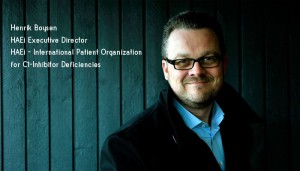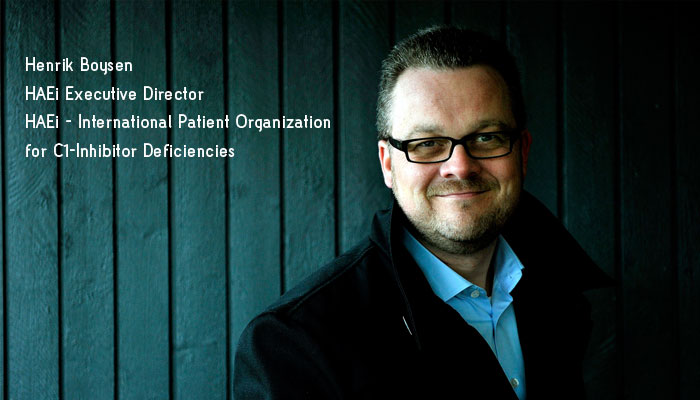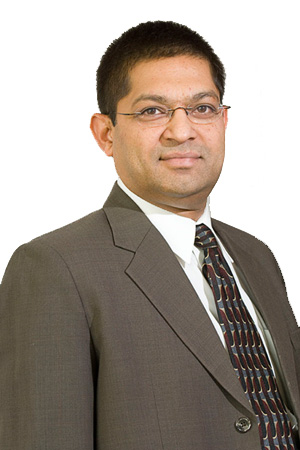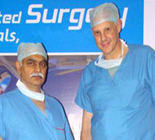The mHealth business provides health and wellness solutions, to companies & consumers, using innovative combination of IT and telecommunications, with traditional medical care; these solutions are offered over telephony & internet channels maximizing their availability and affordability. We launched a free health concierge & referral service, Healthline24X7, more than a year back, which provides callers with all possible information on diseases, drugs, treatments, and allows callers to find the most appropriate healthcare provider based on their specific needs.

HAEi Executive Director
1. Health is a buzzword today, as diseases increase with time Healthcare is being judged as unique sector with varied demands and need! What is your perception in this regard?
Healthcare certainly is a unique sector. I know from my work with the HAEi – International Patient Organization for C1-Inhibitor Deficiencies – that each and every patient has different challenges and needs. That’s why we are helping to create HAE national member organizations and patient groups all over the world so that really local support is available on the ground. As a global umbrella organization, we see many varying levels of understanding, care and access to treatment in different countries and regions. Our aim is that everyone with the condition has access to life-saving therapies and diagnosis on a worldwide basis, enabling them to have the best possible chance of leading the life they wish for.
2. Can you enlighten us about HAE (Hereditary angioedema) and HAEi and what it does?
Hereditary angioedema (HAE) is a very rare and potentially life-threatening genetic condition that occurs in about 1 in 10,000 to 1 in 50,000 people. HAE symptoms include episodes of edema (swelling) in various body parts including the hands, feet, face and airway.
In addition, patients often have bouts of excruciating abdominal pain, nausea and vomiting that is caused by swelling in the intestinal wall. Airway swelling is particularly dangerous and can lead to death by asphyxiation.
On average it can take about 13 years for a patient to be diagnosed with HAE as the symptoms
are similar to those of many other common conditions such as allergies or appendicitis.
HAE
HAEi – International Patient Organization for C1-Inhibitor Deficiencies – is a global organization dedicated to raising awareness of C1-inhibitor deficiencies around the world. It is a non-profit international network of national HAE patient associations.
3. Can you tell us more about angioedema due to C1-Inhibitor deficiency?
There are two different subtypes (2) of HAE based on the underlying genetic defect in the control of the blood protein C1-esterase inhibitor:
- Type I HAE: This subtype is characterized by decreased levels of functional C1-INH protein. About 80-85% of patients suffer from this form of the disease.
- Type II HAE: This type is associated with normal or increased levels of a dysfunctional C1-INH protein resulting in reduced levels of C1-INH activity.
- Type III HAE: Recently a type III has been postulated: HAE type III arises independently of a C1-INH deficiency. It is relatively rare and primarily affects women. In some patients a mutation of factor XII was found.(15, 16-18)
Hereditary angioedema of type I and type II is caused by a defect (mutation) in the gene responsible for producing the protein C1 esterase inhibitor (C1-INH). Unlike other hereditary diseases, the healthy gene cannot compensate for the defect in the other gene in patients with HAE. Therefore, a child has a 50% chance of developing HAE if one parent has the gene mutation.(2,14)
Under normal conditions, C1-INH regulates the body’s production of bradykinin, a locally acting hormone that plays an important role in the control of the dilation (widening) and permeability of blood vessels – for example, in response to an injury or infection. If the C1-INH is not functioning properly or if its concentration is decreased, bradykinin is released excessively resulting in local swellings (edema).
Besides the contact system, C1-INH is also involved in the so called complement system which is part of the immune defense. As in the contact system, an external stimulus, for example a foreign body or microbe, triggers a reaction cascade which aims to eliminate the alien.
The cascade starts with the protein C1, whose direct counterpart is C1-INH. C1 is activated as soon as the immune system detects a foreign body, although the process is also self-activating to a lesser extent. Activated C1 activates a series of other factors in the complement system resulting in the elimination of the pathogen.
Infections, injuries, operations or stress(8) may lead to consumption of C1-INH and may thus result in elevation of bradykinin levels with subsequent edema formation. Drugs that lower blood pressure (ACE inhibitors) can also cause edema: by inhibiting the degradation of bradykinin its level is increased.
Please find references here: http://haei.org/node/600
4. What issues do you believe will be addressed while promoting the HAE Day and through HAE Community?
I think people with HAE face different issues and challenges depending on where they live but clearly a lot of patients are frustrated about the low awareness of HAE and they’re also frustrated about not having access to proper diagnoses and proper treatments.
So the official objective of hae day 🙂 is to raise awareness of hereditary angioedema among the general public and medical community, with the aim of creating an environment in which there is better care, earlier and more accurate diagnosis and knowledge that HAE patients can lead a healthy life.
One of the ways we hope to raise awareness with hae day 🙂 is our ‘Cover the world with smiles’ campaign which allows people to share a virtual smile with our website, www.haeday.org. Over 500 people have sent their smiles and messages which is a great result.
Last weekend, May 17 – 20, we also held the first true global conference for HAE patients, care-givers, healthcare professionals and industry representatives conducted and driven by the patient community through HAEi. Held in Copenhagen, it was a great success and there was a lot of constructive discussion on how we can secure access to life-saving therapies and diagnosis on a worldwide basis.
The support for hae day 🙂 and the 2012 HAE Global Conference has been really encouraging and demonstrates how far the HAE community has come in recent years. We’ve worked together to raise awareness and funds that will enable our national member organizations all over the world carry on their great work supporting patients. But there is more work to be done to ensure everyone with HAE is properly diagnosed and has access to appropriate therapy.
5. How do you see the needs of individuals with Hereditary Angioedema changing over the next five years?
We have to remember firstly that many people in different countries around the world are still undiagnosed and are not receiving care appropriate to their condition. And even when they have been diagnosed, access to newly available treatments is impossible for patients in many places.
But where new treatments are available, people are going to be expecting more from their medication. It is becoming more and more popular to treat at home or away from a medical environment – if you are travelling or at work, for example. Within the diagnosed community, our HAE patients are starting to realize that with the right care and medication, their lives do not have to stop. We have a duty to show our children and their children that HAE is a manageable disease and when it’s treated properly they can live a flexible and full life. The awareness generated during hae day 🙂 and the 2012 HAE Global Conference will ensure these efforts continue in the weeks and months to come.
6. Summarize your priorities as the HAEi Executive Director? What has been your proudest achievement in your work? What do you hope to accomplish during your tenure?
I‘ve been Executive Director since 2009 and that means having the privilege of running the day-to-day operations and gathering the world of HAE patients under the umbrella of the HAEi, helping them to manage and create national member organizations and patient groups worldwide.
Since our foundation in 2004 I think the HAEi has achieved a lot. From a personal point of view, and since my appointment, I’m in particular happy about our online offering – our website and the hae day 🙂 website, our online community for patients and their direct relatives, and our social media presence. This all helps us raise awareness and drives new contacts to us as well.
The fact that we grew from 12 to 15 member countries in 2009 up to 36 member countries today is something else we at HAEi can be proud of.
And obviously the last week has seen both hae day 🙂 and the first truly global conference on HAE so that’s been pretty momentous. Just to see so many people involved with the cause and embracing the spirit of the initiative has made me very proud and truly hopeful about the future for people with HAE.
7. How do you believe it is best to work with industry in order to achieve common goals such as HAE awareness, its emergency, and its cures?
It is in the interests of all HAE patients for us to work closely with pharmaceutical companies and healthcare professionals to spread awareness of HAE and secure access to life-saving therapies and diagnosis on a worldwide basis. This was proved at last weekend’s 2012 HAE Global Conference in Copenhagen where we had patients, care-givers, healthcare professionals and industry representatives from 37 countries all gathered together in one place. Ultimately we are all working towards the same goals and the conference allowed us to have some really valuable discussion and share ideas for making life better for all HAE patients.
8. Tell us something about your future endeavors, and technologies being produced for the rare disease HAE?
As I mentioned above, in many countries there are currently no acute attack treatments available for HAE patients. In those countries physicians are therefore limited to providing patients with steroids or in some cases tranexamic acid. Therefore a real goal has to be to make sure everyone around the world has access to the more recently developed life-saving therapies.
That said, the scientific track at the 2012 HAE Global Conference in Copenhagen allowed us to hear about some of the latest research into HAE which is always exciting and will help us work towards even better care for patients.
As far as HAEi is concerned, we want to extend our reach to help patients all over the world by helping create even more national member organizations and national patient groups.
Magnum HIS is a comprehensive Hospital Information System (HIS) for managing the workflow processes across the healthcare enterprise. It covers entire hospital workflows from patient registration to creation of balance sheet. Magnum PACS is a complete Web based, enterprise class, Picture Archival & Communication System, offering a comprehensive and fully integrated solution for digital imaging. Magnum Kiosk enables self-service experience for patients to manage their contact details or view their outstanding invoices using touch screen technology. Magnum Portal is a web based portal that allows the patient to interact and communicate with their Healthcare providers, namely physicians and hospitals.
The mHealth business provides health and wellness solutions, to companies & consumers, using innovative combination of IT and telecommunications, with traditional medical care; these solutions are offered over telephony & internet channels maximizing their availability and affordability. We launched a free health concierge & referral service, Healthline24X7, more than a year back, which provides callers with all possible information on diseases, drugs, treatments, and allows callers to find the most appropriate healthcare provider based on their specific needs.
Our Mediphone service, launched in partnership with Airtel, provides 24X7 medical advice to Airtel mobile subscribers, giving them the ability to consult a doctor on demand, over the phone from anywhere, at any time.
With the white-labeled Medi-Consult platform, we are working with corporates and health providers, extending the on demand “doctor on call” service to their users and patients. With Medi-Consult, our partner in the Insurance space is able to provide unique and round the clock medical offerings to its policy holders. The CDM solutions are working for health providers to help their patients better manage chronic and lifestyle ailments.
9. You must have worked on various policies for the patients as well as organizations. What was the impact of these policies for patients and for patients’ organizations?
We at the HAEi are looking to develop and support national member organizations and national patient groups in as many countries as possible around the world. Every HAE patient deserves to have local support and we hope this will ultimately lead to everyone having access to diagnosis and life-saving treatments.





